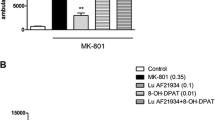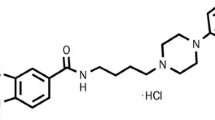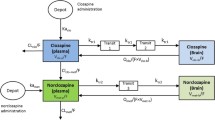Abstract
The administration of neuroleptics in animal models has been extensively reported and plays an important role in the study of schizophrenia. Our study was designed to address the following questions: (1) Is it possible to achieve steady-state receptor occupancy levels administering neuroleptics in drinking water? (2) Is there an appropriate dose to obtain clinically comparable receptor occupancies? (3) Is there a correlation between plasma drug levels and receptor occupancy? Thus, we tested three neuroleptic drugs administered in drinking water for 7 days. Plasma drug levels were measured, and in vivo receptor occupancy assays were performed in order to determine peak and trough dopamine D2 receptor occupancies in striatal brain samples. Overall, our study indicates that in rodents the administration of appropriate doses of haloperidol and olanzapine in drinking water achieves receptor occupancies comparable to the clinical occupancy levels, but this appears not to be the case for clozapine.


Similar content being viewed by others
References
Aravagiri M, Ames D, Wishing WC, Marder SR (1997) Plasma level monitoring of olanzapine in patients with schizophrenia: determination by high-performance liquid chromatography with electrochemical detection. Ther Drug Monit 19:307–313
Aravagiri M, Teper Y, Marder SR (1999) Pharmacokinetics and tissue distribution of olanzapine in rats. Biopharm Drug Dispos 20:369–377
Baldessarini RJ, Centorrino F, Flood JG, Volpicelli SA, Huston-Lyons D, Cohen BM (1993) Tissue concentrations of clozapine and its metabolites in the rat. Neuropsychopharmacol 9:117–124
Bezchlibnyk-Butler KZ, Jeffries JJ (eds) (1999) Clinical handbook of psychotropic drugs. Hogrefe and Huber Publishers, Toronto
Bianchetti G, Morselli PL (1978) Rapid and sensitive method for determination of haloperidol in human samples using nitrogen–phosphorus selective detection. J Chromatogr 153:203–209
Catlow JT, Barton RD, Clemens M, Gillespie TA, Goodwin M, Swanson SP (1995) Analysis of olanzapine in human plasma utilizing reversed-phase high performance liquid chromatography with electrochemical detection. J Chromatogr 668:85–90
Ceresoli-Borroni G, Rassoulpour A, Wu HQ, Guidetti P, Schwarcz R (2006) Chronic neuroleptic treatment reduces endogenous kynurenic acid levels in rat brain. J Neural Transm 113:1355–1365
Cheng YF, Paalzow LK (1992) Linear pharmacokinetics of halperidol in the rat. Biopharm Drug Dispos 13:69–76
Farde L, Wiesel FA, Halldin C, Sedwall G (1988) Central D2-dopamine receptor occupancy in schizophrenic patients treated with antipsychotic drugs. Arch Gen Psychiatr 45:71–76
Fell MJ, Neill JC, Rao C, Marshall KM (2005) Effects of sub-chronic antipsychotic drug treatment on body weight and reproductive function in juvenile female rats. Psychopharmacology (Berl) 182:499–507
Gao XM, Hashimoto T, Cooper TB, Tamminga CA (1997) The dose-response characteristics of rat oral dyskinesias with chronic haloperidol administration. J Neural Transm 104:97–104
Gao XM, Cooper T, Suckow RF, Tamminga CA (2005) Multidose risperidone treatment evaluated in a rodent model of tardive dyskinesia. Neuropsychopharmacol 23:1–5
Kaneda H, Shirakawa O, Dale J, Goodman L, Bachus SE, Tamminga CA (1992) Co-administration of probabide inhibits haloperidol-induced oral dyskinesias. Eur J Pharmacol 212:43–49
Kapur S, Seeman P (2001) Does fast dissociation from the dopamine D2 receptor explain the action of atypical antipsychotics?: a new hypothesis. Am J Psychiat 159:360–369
Kapur S, Zipursky R, Remington G (1999) Clinical and theoretical implications of 5-HT2 and D2 receptor occupancy of clozapine, risperidone and olanzapine in schizophrenia. Am J Psychiat 156:286–293
Kapur S, Wadenberg ML, Remington G (2000) Are animal studies of antipsychotics appropriately dosed. Lessons from the bedside to the bench. Can J Psychiat 45:241–246
Kapur S, Vanderspek SC, Brownlee BA, Nobrega J (2003) Antipsychotic dosing in preclinical models is often unrepresentative of the clinical condition: a suggested solution based on in vivo occupancy. J Pharmacol Exp Ther 305:625–631
Kelley JJ, Roberts RC (2004) Effects of haloperidol on cholinergic striatal interneurons: relationship to oral dyskinesias. J Neural Transm 111:1075–1091
Kelley JJ, Gao XM, Tamminga CA, Roberts RC (1997) The effect of chronic haloperidol treatment on dendritic spines in the rat striatum. Exp Neurol 146:471–478
Kleven MS, Assie MB, Cosi C, Barret-Grevoz C, Newman-Tancredi A (2005) Anticataleptic properties of α2 adrenergic antagonists in the crossed leg position and bar tests: differential mediation by 5-HT1A receptor activation. Psychopharmacology 177:373–380
Lipska BK, Weinberger DR (2000) To model a psychiatric disorder in animals: schizophrenia as a reality test. Neuropsychopharmacol 23:223–239
Lowry OH, Rosebrough NJ, Farr AL, Randall RJ (1951) Protein measurement with the folin phenol reagent. J Biol Chem 193:265–275
Mitchell PJ, Redfern PH (2005) Animal models of depressive illness: the importance of chronic drug treatment. Curr Pharm Design 11:171–203
Ossowska K, Pietraszek M, Wardas J, Dziedzicka-Wasylewska M, Nowicka D, Wolfarth S (2002) Chronic treatments with haloperidol and clozapine alter the level of NMDA-R1 mRNA in the rat brain: an in situ hybridization study. Pol J Pharmacol 54:1–9
Perez-Costas E, Guidetti P, Kelley JJ, Melendez-Ferro M, Roberts RC (2005) Neuroleptics and animal models: feasibility of oral treatment monitored by plasma levels and receptor occupancy assays. Program No.914.18. 2005 Abstract viewer/Itinerary planner. Society for Neuroscience, Washington. On line
Perez-Costas E, Guidetti P, Kelley JJ, Melendez-Ferro M, Roberts RC (2006) Feasibility of antipsychotic oral treatments in animal models monitored by plasma levels and receptor occupancy assays. FENS Abstr 3:A059
Perrone JA, Chabla JM, Hallas BH, Horowitz JM, Torres G (2004) Weight loss dynamics during combined fluoxetine and olanzapine treatment. BMC Pharmacol 4:27
Pillai A, Mahadik SP (2006) Differential effects of haloperidol and olanzapine on levels of vascular endothelial growth factor and angiogenesis in rat hippocampus. Schizophr Res 87:48–59
Pouzet B, mow T, Kreilgaard M, Velschow S (2003) Chronic treatment with antipsychotics in rats as a model for antipsychotic-induced gain weight in human. Pharmacol Biochem Be 75:133–140
Prinssen EPM, Kleven MS, Koek W (1999) Interactions between Neuroleptics and 5-HT1A ligands in preclinical behavioral models for antipsychotic and extrapyramidal effects. Psychopharmacology 144:20–29
Roberts RC (2001) Effect of chronic olanzapine treatment on striatal synaptic organization. Synapse 39:8–15
Roberts RC, Lapidus B (2003) Ultrastructural correlates of haloperidol-induced oral dyskinesias in rats: a study of unlabeled and enkephalin-labeled striatal terminals. J Neural Transm 110:961–975
Roberts RC, Gaither LA, Gao XM, Kashyap SM, Tamminga CA (1995) Ultrastructural correlates of haloperidol-induced oral dyskinesias in rat striatum. Synapse 20:234–243
Roberts RC, Force M, King L (2002) Dopaminergic synapses in the matrix of the ventromedial striatum after chronic haloperidol treatment. Synapse 45:78–85
Rosengarten H, Bartoszyk GD, Quartermain D, Lin Y (2006) The effect of chronic administration of sarizotan, 5-HT1A agonist/D3/D4 ligand, on haloperidol-induced repetitive jaw movements in rat model of tardive dyskinesia. Prog Neuro-Psychoph 30:273–279
Sakai K, Gao XM, Hashimoto T, Tamminga CA (2001a) Traditional and new antipsychotic drugs differentially alter neurotransmission markers in basal ganglia-thalamocortical neural pathways. Synapse 39:152–160
Sakai K, Gao XM, Tamminga CA (2001b) Scopolamine fails to diminish chronic haloperidol-induced purposeless chewing in rats. Psychopharmacology 153:191–195
Schleimer SB, Johnston GAR, Henderson JM (2005) Novel oral drug administration in an animal model of neuroleptic therapy. J Neurosci Method 146:159–164
Schmitt A, Weber S, Jatzko A, Braus DF, Henn FA (2004) Hippocampal volume and cell proliferation after acute and chronic Clozapine or haloperidol treatment. J Neural Transm 111:91–100
Schmitt U, Dahmen N, Fischer V, Weigmann H, Rao M, Reuss SCH (1999) Chronic oral haloperidol and clozapine in rats: a behavioral evaluation. Neuropsychobiology 39:86–91
Simpson GM, Cooper TB (1978) Clozapine plasma levels and convulsions. Am J Psychiat 135:99–100
Stahle L, Ungerstedt U (1986) Effects of neuroleptic drugs on the inhibition of exploratory behavior induced by a low dose of apomorphine: implications for the identity of dopamine receptors. Pharmacol Biochem Behav 25:473–480
Tamminga CA, Dale JM, Goodman L, Kaneda H, Kaneda N (1990) Neuroleptic-induced vacuous chewing movements as an animal model of tardive dyskinesia: a study in three rat strains. Psychopharmacology 102:474–478
Terry AV Jr, Gearhart DA, Mahadik SP, Warsi S, Waller JL (2006) Chronic treatment with first or second generation antipsychotics in rodents: effects on high affinity nicotinic and muscarinic acetylcholinic receptors in the brain. Neuroscience 140:1277–1287
Wadenberg MLG, Soliman A, VanderSpek SC, Kapur S (2001) Dopamine D2 receptor occupancy is a common mechanism underlying animal models of antipsychotics and their clinical effects. Neuropsychopharmacology 25:633–641
Weigmann H, Hartter s, Fischer V, Dahmen N, Hiemke C (1999) Distribution of clozapine and desmethylclozapine between blood and brain in rats. Eur Neuropsychopharm 9:253–256
Acknowledgments
We wish to thank Elli Lilly and Co. (Indianapolis, IN, USA) for the donation of the olanzapine used in this study, and Novartis (Basel, Switzerland) for the donation of the clozapine. This work was supported by NIH grant MH66123.
Author information
Authors and Affiliations
Corresponding author
Rights and permissions
About this article
Cite this article
Perez-Costas, E., Guidetti, P., Melendez-Ferro, M. et al. Neuroleptics and animal models: feasibility of oral treatment monitored by plasma levels and receptor occupancy assays. J Neural Transm 115, 745–753 (2008). https://doi.org/10.1007/s00702-007-0004-5
Received:
Accepted:
Published:
Issue Date:
DOI: https://doi.org/10.1007/s00702-007-0004-5




